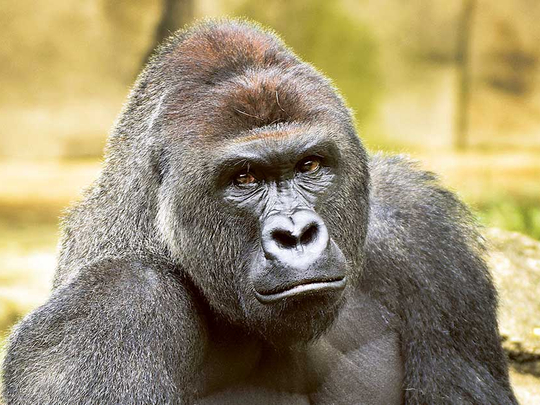
Harambe, the 17-year-old Western lowland gorilla shot dead at the Cincinnati Zoo late last month after a 3-year-old boy fell into his enclosure, may be physically gone, his tissues harvested for research and his sperm extracted to help diversify the captive breeding gene pool.
Yet the 200kg silverback leaves another metaphorical gorilla in the room, raising questions that extend far beyond the particulars of the case, including whether the zoo or the boy’s mother were more to blame for Harambe’s death.
For primatologists and conservationists who devote their lives to studying the great apes and to doing what they can to help protect the rapidly vanishing populations of the primates in the wild, a linked set of ethical and practical dilemmas looms almost unbearably large.
As research continues to reveal the breadth of our genetic, emotional and cognitive kinship with the world’s four great apes — gorillas, chimpanzees, bonobos and orangutans — many primatologists admit to feeling frankly uncomfortable at the sight of a captive ape on display, no matter how luxe or “natural” the zoo exhibit may be.
“When I visit zoos, I have to turn off my feelings and just tell myself that I am at a museum admiring nature’s masterpieces,” said the primatologist Sarah Blaffer Hrdy, professor emerita at the University of California, Davis. “Otherwise, I can’t really justify keeping great apes in cages.”
At the same time, researchers acknowledge that apes in today’s zoos, at least in the industrialised world, were all born and raised in captivity, and could no more survive being “set free” into the forests of Africa or Indonesia than could the average tourist on safari.
Yet while primatologists concur that people have a moral obligation to care for the thousands of apes who are now in captivity and may live 60 years or longer, they differ on what that care should look like.
Catherine Hobaiter of St Andrews University in Scotland, who studies chimpanzees in Uganda, described the reaction of zoo gorillas that had been raised in indoor enclosures when the zoo finally added an outdoor annexe to the exhibit.
“It was heartbreaking to see,” she said. “The gentlest specks of rain, and the gorillas were drumming to get back inside. They were afraid of getting wet.”
Barbara Smuts, a renowned primatologist at the University of Michigan, recently distributed a petition asking that the other gorillas at the Cincinnati Zoo be relocated to a sanctuary far from the ogling, screeching crowds.
Researchers also disagree on whether we should continue breeding apes in captivity, and if so, to what end. Some experts believe that well-designed zoos play an essential educational role, and that exposure to a flesh-and-blood ape can be a transformative experience, especially for children.
“I remember going to the Milwaukee zoo when I was a kid and seeing the gorilla,” said Peter Walsh, a biological anthropologist at Cambridge University who works on gorilla conservation in Africa. “I was rapt. You don’t get that emotional bond from an IMAX movie.”
Others deride most zoos as little more than amusement parks with educational placards that few people bother to read.
“There’s no good evidence that captive apes are having any positive effect on their wild relatives,” said Marc Bekoff, a behavioural ecologist and professor emeritus at the University of Colorado. As for education, he added, “one of the most wonderful and educational lessons in biodiversity I’ve ever seen was a snail exhibit at the Detroit Zoo”.
Peter Singer, a bioethicist at Princeton University, said, “Our primary concern ought to be the well-being of gorillas, but zoos are constructed the other way around: the primary concern is that humans can see the gorillas.”
No matter their feelings about zoos, primatologists despair at the shocking statistics on wild apes.
According to the IUCN Red List of Threatened Species, all species and subspecies of wild apes rank as endangered or critically endangered, and in all cases, the trends point implacably downward. Apes are being lost to poaching, the bushmeat trade, habitat destruction and disease.
In Sumatra and Borneo, forests have been pulped to make way for palm oil plantations, with devastating consequences for orangutans. Since the 1990s, 80 per cent of Eastern lowland gorillas in Central Africa have died of Ebola.
According to meta-analyses of intelligence studies, the average ape has the cognitive, quantitative and spatial skills of a 2 1/2- to 4-year-old human child. Yet Tetsuro Matsuzakawa’s laboratory in Japan showed that an exceptionally sharp-witted chimpanzee named Ayuma was twice as good as any university student at recalling numbers flashed on a screen.
The great apes also exhibit basic temperamental differences. David Watts, a primatologist at Yale University who has studied chimpanzees and gorillas in the wild, found that while chimpanzees generally didn’t like people or show much interest in their affairs, gorillas were deeply curious.
“I quickly realised that the gorillas not only wanted to touch me, but to climb all over me,” he said. In one famous incident, a female gorilla stuck her hand down the shirt of a female primatologist.
That innate curiosity, researchers suggest, may explain some of Harambe’s behaviour seen on the video of his fatal encounter with the boy who fell into his enclosure — fiddling with the boy’s clothing, taking a quick peek as he pulled the boy’s pants upward. He tried pulling the boy into a grotto, perhaps to protect him or to claim the fascinating new playmate for himself.
But with the mounting commotion and screams from the onlookers above, researchers said, Harambe grew agitated and soon assumed the stance of a male silverback in dominance display mode.
“It’s what we used to call strutting, and male gorillas do it all the time,” Watts said. “A silverback will stand or walk around with arms and legs stiffly extended, his hair piloerect, to make himself look bigger and more impressive. Harambe was definitely doing that when he was standing over the boy.”
The behaviour is mostly bluster: if Harambe had been intent on killing the boy, Hrdy said, as an interloping male gorilla might kill the babies sired by the silverback he just deposed — the quicker to claim the resident females for himself — “he would have done it in seconds,” probably with a stereotypical bite to the skull.
Nevertheless, the strut introduced risks of its own, particularly when Harambe began dragging the boy around the enclosure, as a displaying gorilla will sometimes drag around a large branch.
Watts, who said he had been “punched, knocked over and dragged” by male gorillas but never seriously injured, wishes he had been at the Cincinnati Zoo as the crisis unfolded. He would have volunteered to enter the enclosure and assume a submissive foetal position on the floor to try drawing the gorilla’s attention from the boy.
The look and logic of zoos have changed drastically over time. When the first apes were exhibited in the West, in the late 18th century, they were seen as trophies, evidence of imperial victory over savagery. The unfortunate souvenirs usually died within months of their arrival from disease or malnutrition.
As zoos sought to improve the health of their resident apes, the enclosures often assumed a blandly sterile configuration, devoid of risky foliage or toys. That approach led to problems of its own, such as boredom, repetitive behaviours and depression.
More recently, most zoos have worked hard to give apes the mental and emotional stimulation they need, with tyres for swinging, rocks for climbing, social groups for mutual grooming or bouts of contagious laughing or yawning.
Frans de Waal of Emory University and the Yerkes National Primate Research Center said he was a “big fan” of quality zoos, although perhaps not for large, gregarious animals such as killer whales and elephants. “But for great apes, the record now is excellent,” he said.
But what the public must accept, he said, is that the pleasant notion of zoos as nurseries for restocking wild populations of endangered animals has proved a fantasy in all but a handful of cases, most notably the successful reintroduction of zoo-bred golden lion tamarins into the rain forests of South America.
By contrast, when the British aristocrat Damian Aspinall released 11 of his captive-bred lowland gorillas into the wilds of Gabon last year, five were soon violently dispatched, probably by a resident gorilla, while the rest disappeared.
–New York Times News Service











